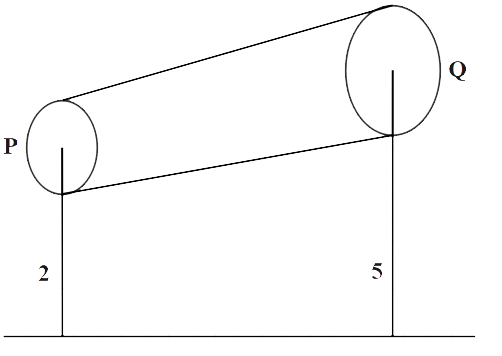
A non-viscous liquid of constant density \[1000kg/{{m}^{3}}\] flows in a streamline motion along a tube of variable cross section. The tube is kept inclined in a vertical plane as shown in the figure. The area of cross section of tube at two points P and Q at heights of 2m and 5m are respectively \[4\times {{10}^{-3}}{{m}^{2}}\] and \[{{A}_{2}}=8\times {{10}^{-3}}{{m}^{2}}\] . The velocity of liquid at point P is 1 m/s. Find the work done per unit volume by the pressure and the gravity forces as the liquid flows from point P to Q. Take \[g=9.8m/{{s}^{2}}\]


Answer
574.8k+ views
Hint: To solve this question we will need the pressure across the points as the liquid flows from point P to point Q. To do that, we will first find velocity at point Q as it is not given and then using this value find the pressure across points P and Q. To find the pressure and work done by it we will use Bernoulli’s equation. To find the work done by gravity we will use the equation of potential energy between the given points.
Formula used:
\[{{A}_{1}}{{v}_{1}}={{A}_{2}}{{v}_{2}}\]
\[{{p}_{1}}+\dfrac{1}{2}\rho v_{1}^{2}+\rho g{{h}_{1}}={{p}_{2}}+\dfrac{1}{2}\rho v_{2}^{2}+\rho g{{h}_{2}}\]
Complete answer:
Let \[{{W}_{1}}\] = work done by pressure and \[{{W}_{2}}\]= work done by gravity.
To solve this problem we will first need to find the velocity at point Q
So, using the given data
\[{{A}_{1}}=4\times {{10}^{-3}}{{m}^{2}}\]
\[{{A}_{2}}=8\times {{10}^{-3}}{{m}^{2}}\]
\[\rho ={{10}^{3}}kg/{{m}^{3}}\]
\[{{v}_{1}}\]= 1 m/s
Now using equation of continuity
\[{{A}_{1}}{{v}_{1}}={{A}_{2}}{{v}_{2}}\]
We get,
\[{{v}_{2}}=\left( \dfrac{{{A}_{1}}}{{{A}_{2}}} \right){{v}_{1}}\]
Substituting the given values,
We get,
\[{{v}_{2}}=\left( \dfrac{4\times {{10}^{-3}}}{4\times {{10}^{-3}}} \right)\times 1\]
\[\therefore {{v}_{2}}=\dfrac{1}{2}m/s\] …….. (1)
Now, using Bernoulli’s equation to find work done by pressure
\[{{p}_{1}}+\dfrac{1}{2}\rho v_{1}^{2}+\rho g{{h}_{1}}={{p}_{2}}+\dfrac{1}{2}\rho v_{2}^{2}+\rho g{{h}_{2}}\]
On rearranging the terms,
\[{{p}_{1}}-{{p}_{2}}=\rho g\left( {{h}_{2}}-{{h}_{1}} \right)+\dfrac{1}{2}\rho \left( v_{2}^{2}-v_{1}^{2} \right)\] ………….. (2)
We get the Work energy principle.
Therefore,
\[{{W}_{1}}={{p}_{1}}-{{p}_{2}}\]
So from (1) and (2)
We get,
\[{{W}_{1}}\]=\[{{p}_{1}}-{{p}_{2}}=\left[ \left( {{10}^{3}} \right)\left( 9.8 \right)\left( 5-2 \right)+\dfrac{1}{2}\left( {{10}^{3}} \right)\left( \dfrac{1}{4}-1 \right) \right]\]
\[\therefore {{p}_{1}}-{{p}_{2}}=29025J/{{m}^{3}}\]
Therefore, work done by pressure is \[{{W}_{1}}\]=\[29025J/{{m}^{3}}\]
Now, for work done by gravity we shall use the equation of potential energy
\[{{W}_{2}}=\rho g\left( {{h}_{2}}-{{h}_{1}} \right)\]
Substituting the values
We get,
\[{{W}_{2}}=\left( {{10}^{3}} \right)\left( 9.8 \right)\left( 5-2 \right)\]
\[{{W}_{2}}=29400J/{{m}^{3}}\]
Therefore, the work done by gravity is \[{{W}_{2}}=29400J/{{m}^{3}}\]
Note:
We have used Bernoulli's equation to find the net work done because as the fluid flows from a narrow channel to a broad one the kinetic energy of fluid increases and vice versa. This change in kinetic energy occurs due to net work done on the fluid to push it further in a channel and work done by gravitational force, if there is change in vertical position of fluid.
Formula used:
\[{{A}_{1}}{{v}_{1}}={{A}_{2}}{{v}_{2}}\]
\[{{p}_{1}}+\dfrac{1}{2}\rho v_{1}^{2}+\rho g{{h}_{1}}={{p}_{2}}+\dfrac{1}{2}\rho v_{2}^{2}+\rho g{{h}_{2}}\]
Complete answer:
Let \[{{W}_{1}}\] = work done by pressure and \[{{W}_{2}}\]= work done by gravity.
To solve this problem we will first need to find the velocity at point Q
So, using the given data
\[{{A}_{1}}=4\times {{10}^{-3}}{{m}^{2}}\]
\[{{A}_{2}}=8\times {{10}^{-3}}{{m}^{2}}\]
\[\rho ={{10}^{3}}kg/{{m}^{3}}\]
\[{{v}_{1}}\]= 1 m/s
Now using equation of continuity
\[{{A}_{1}}{{v}_{1}}={{A}_{2}}{{v}_{2}}\]
We get,
\[{{v}_{2}}=\left( \dfrac{{{A}_{1}}}{{{A}_{2}}} \right){{v}_{1}}\]
Substituting the given values,
We get,
\[{{v}_{2}}=\left( \dfrac{4\times {{10}^{-3}}}{4\times {{10}^{-3}}} \right)\times 1\]
\[\therefore {{v}_{2}}=\dfrac{1}{2}m/s\] …….. (1)
Now, using Bernoulli’s equation to find work done by pressure
\[{{p}_{1}}+\dfrac{1}{2}\rho v_{1}^{2}+\rho g{{h}_{1}}={{p}_{2}}+\dfrac{1}{2}\rho v_{2}^{2}+\rho g{{h}_{2}}\]
On rearranging the terms,
\[{{p}_{1}}-{{p}_{2}}=\rho g\left( {{h}_{2}}-{{h}_{1}} \right)+\dfrac{1}{2}\rho \left( v_{2}^{2}-v_{1}^{2} \right)\] ………….. (2)
We get the Work energy principle.
Therefore,
\[{{W}_{1}}={{p}_{1}}-{{p}_{2}}\]
So from (1) and (2)
We get,
\[{{W}_{1}}\]=\[{{p}_{1}}-{{p}_{2}}=\left[ \left( {{10}^{3}} \right)\left( 9.8 \right)\left( 5-2 \right)+\dfrac{1}{2}\left( {{10}^{3}} \right)\left( \dfrac{1}{4}-1 \right) \right]\]
\[\therefore {{p}_{1}}-{{p}_{2}}=29025J/{{m}^{3}}\]
Therefore, work done by pressure is \[{{W}_{1}}\]=\[29025J/{{m}^{3}}\]
Now, for work done by gravity we shall use the equation of potential energy
\[{{W}_{2}}=\rho g\left( {{h}_{2}}-{{h}_{1}} \right)\]
Substituting the values
We get,
\[{{W}_{2}}=\left( {{10}^{3}} \right)\left( 9.8 \right)\left( 5-2 \right)\]
\[{{W}_{2}}=29400J/{{m}^{3}}\]
Therefore, the work done by gravity is \[{{W}_{2}}=29400J/{{m}^{3}}\]
Note:
We have used Bernoulli's equation to find the net work done because as the fluid flows from a narrow channel to a broad one the kinetic energy of fluid increases and vice versa. This change in kinetic energy occurs due to net work done on the fluid to push it further in a channel and work done by gravitational force, if there is change in vertical position of fluid.
Recently Updated Pages
Master Class 11 Economics: Engaging Questions & Answers for Success

Master Class 11 English: Engaging Questions & Answers for Success

Master Class 11 Social Science: Engaging Questions & Answers for Success

Master Class 11 Biology: Engaging Questions & Answers for Success

Class 11 Question and Answer - Your Ultimate Solutions Guide

Master Class 11 Business Studies: Engaging Questions & Answers for Success

Trending doubts
What is meant by exothermic and endothermic reactions class 11 chemistry CBSE

1 Quintal is equal to a 110 kg b 10 kg c 100kg d 1000 class 11 physics CBSE

What is periodicity class 11 chemistry CBSE

Explain zero factorial class 11 maths CBSE

What is a periderm How does periderm formation take class 11 biology CBSE

What are porins class 11 biology CBSE




